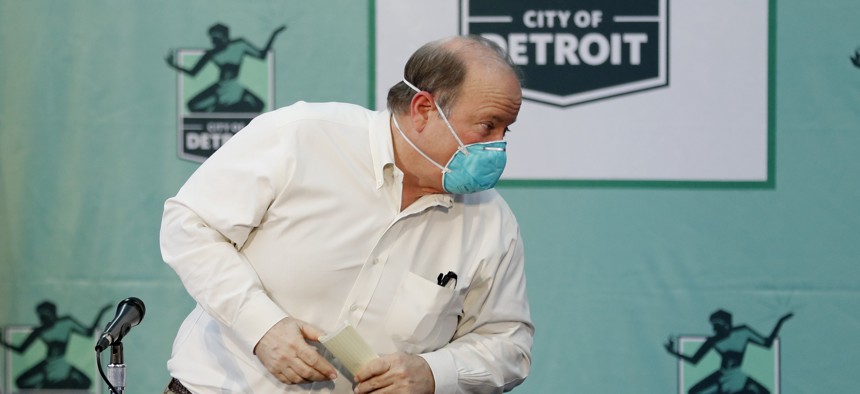In a City That Was a Coronavirus Hotspot, More Public Employees Will Return to Work

Detroit Mayor Mike Duggan exits a news briefing in April after announcing layoffs, pay cuts for other employees and and a reduction in some services. On Monday, he said up to 200 workers would soon return to their normal duties. AP Photo/Carlos Osorio
Connecting state and local government leaders
Hundreds of workers in Detroit saw their pay and hours slashed in recent weeks as the city reeled from the virus outbreak.
Detroit will bring back 150 to 200 municipal workers in the next week who’d seen their jobs disrupted by the coronavirus. The move comes amid signs the outbreak is easing in the city.
Mayor Mike Duggan said that the workers who would be returning would include building, construction and property maintenance inspectors, a number of lawyers in the city’s law department and staff members who work on housing repairs.
Local governments around the country have implemented furloughs, layoffs and cuts to hours for their workers, driven by both concerns over employee safety and the financial strain brought on by the sharp drop in tax revenue the virus outbreak has caused.
In some cases there’s also been a lack of work for some public employees to do given that so many people have been mostly staying home and many businesses are shut down.
Duggan last month announced plans to lay off or slash the hours of hundreds of city employees in order to help address a budget gap.
As part of this move, about 900 workers, doing jobs like traffic control and roadwork and handling building permits, saw their hours and pay cut by roughly 90%, but retained their health coverage, according to a presentation the mayor made at that time.
Another 1,300 full-time employees, like office management assistants, accountants, IT staff and financial analysts, faced 20% hour and pay cuts. And 200 part-time, temporary and seasonal workers, like lifeguards and locker room attendants, were laid off.
Like in other state and local governments, many Detroit employees have been doing their jobs from home instead of going into the office.
It wasn’t immediately clear from the mayor’s comments on Monday how many of the returning workers fell into each of these groups.
Detroit, which had seen at least 1,192 coronavirus deaths as of Monday, became one of the nation’s hotspots for the virus. Counties in the area, like Wayne and Oakland, also suffered heavy death tolls, with at least 913 and 849 confirmed fatalities from the virus respectively.
But for the week ending on Friday, the number of deaths in Detroit fell for a third consecutive week to 41, down from 277 back in the week ending April 17.
"It is really remarkable the way that people in the city have embraced social distancing," said Duggan, who noted that based on state guidelines, Michigan has moved with the virus from “uncontrolled growth,” to “persistent spread,” into a “flattening” phase.
“We started off with a lot higher infection rate, it’s come down as we’ve gone along,” he added.
It’s under these circumstances that the city has decided to bring more workers back to their regular duties. Duggan said his goal is for city employees to be as safe at work as they are at home and outlined precautions Detroit has adopted to help meet that standard.
When employees report to work, he said, they have their temperature taken and are asked about possible coronavirus symptoms. Police, firefighters and bus drivers have all been wearing masks, he noted. The city is also testing workers on a regular basis for the virus. "We bring a couple hundred of them in everyday," Duggan said.
Between May 1 and May 11, he said, the city has tested 898 police officers, with 1.5% of them testing positive. Of 229 firefighters tested, about 2% were positive. And the same was true for about 3% of 31 Detroit Department of Transportation workers who were tested.
City employees have fallen victim to the virus. Back in March, a Detroit bus driver, Jason Hargrove, complained in a video posted on Facebook about the safety risks that workers like himself face, and described how a passenger coughed without covering their mouth.
Less than two weeks after posting the video, Hargrove died after contracting Covid-19, the respiratory illness the virus causes.
Late last month, Duggan and union leaders outlined plans for about 200 workers within Detroit’s General Services Department to begin working. Of these workers about 160 are seasonal and do jobs like mowing the grass on city properties. About 40 are drivers.
With this arrangement, a number of precautions were put in place to help prevent the spread of the disease, said city and labor officials.
For example, these employees needed to test negative for the virus to start work, have their temperatures taken when reporting to work and wear masks when close to their coworkers.
The city also expanded the sites they report to from two to five so fewer people gather in each place, and added vehicles so the number of people riding in trucks to job sites was no more than three, instead of five. Standards for sanitizing vehicles were put in place as well.
When the city made its announcement about these plans back in April Duggan estimated that about 5,000 to 5,500 city workers were physically at work and another 1,500 were working from home. The city has around 8,000 full-time workers in total.
Bill Lucia is a Senior Reporter for Route Fifty and is based in Olympia, Washington.

NEXT STORY: Unemployment From the Coronavirus Varies Dramatically Between States, Analysis Finds



